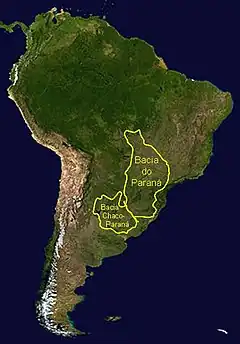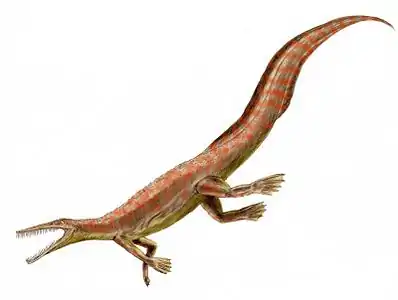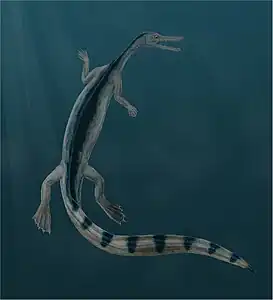| Irati Formation | |
|---|---|
| Stratigraphic range: Early Permian ~ | |
 The Irati Formation belongs to the Gondwana I megasequence | |
| Type | Geological formation |
| Unit of | Passa Dois Group |
| Underlies | Serra Alta Formation (Paraná Basin) Teresina Formation (Pelotas Basin) |
| Overlies | Palermo Formation |
| Area | 1,000,000 km2 (390,000 sq mi) |
| Thickness | up to 80 m (260 ft) |
| Lithology | |
| Primary | Black shale |
| Other | Sandstone |
| Location | |
| Coordinates | 25°30′S 50°42′W / 25.5°S 50.7°W |
| Region | Paraná & Pelotas Basins Goiás, Mato Grosso do Sul, Mato Grosso, São Paulo, Paraná, Santa Catarina, Rio Grande do Sul |
| Country | |
| Type section | |
| Named by | White |
| Year defined | 1908 |
| Approximate paleocoordinates | 45°48′S 29°42′W / 45.8°S 29.7°W |
 The Paraná Basin in South America | |
Irati Formation is the name of a geological formation of the Paraná Basin in Brazil. It has previously been dated as Late Permian using palynomorphs, but is now dated as Early Permian using zircon ages obtained from bentonite layers. The base of the formation has been dated at 278.4 ± 2.2 Ma.[1][2] Exposures of the Irati Formation are to be found in the South (Geopark of Paleorrota), southeastern Brazil and in the states of Goiás, Mato Grosso, São Paulo, Paraná, Santa Catarina, Rio Grande do Sul and Mato Grosso do Sul.[1] The formation is part of the Passa Dios Group, underlying the Serra Alta Formation and overlying the Palermo Formation. The formation has been deposited in a restricted marine environment.[3] The Irati Formation, with a maximum thickness of 80 metres (260 ft), was defined and named by White in 1908.[4]
Fossil content
The formation is particularly famous for the occurrences of the mesosaurs Mesosaurus tenuidiens,[5] and Stereosternum tumidum. Other fossils found in the formation are Myelontordoxylon camposii,[6] and crustaceans of the genera Paulocaris, Pygaspis, Liocaris, and Clarkecaris.[7] It is considered time equivalent to the Whitehill Formation of the Ecca Group of the Karoo Supergroup of southern Africa and the Mangrullo Formation of Uruguay.[8]
 Reconstruction of Mesosaurus
Reconstruction of Mesosaurus Reconstruction of Stereosternum
Reconstruction of Stereosternum
See also
- Geology of Brazil
- Paleontological sites of Brazil
- Ganigobis Formation
References
Bibliography
- Da Costa, Guilherme Estevam. 2015. Fácies sedimentares e composição de folhelhos da Formação Irati (Eopermiano) da Bacia do Paraná na região de Bom Retiro, Leste de Santa Catarina, 1–67. Universidade Federal de Santa Catarina, UFSC. Accessed 2017-08-03.
- Diduch, Ana Paula. 2011. Descrição de Crustacea Malacostraca da Formação Irati, Permiano Superior, Bacia do Paraná, Brasil, 1–52. Universidade Federal do Paraná, UFPR. Accessed 2017-08-03.
- Piñeiro, G.; A. Ramos; C.S. Goso; F. Scarabino, and M. Laurin. 2012. Unusual Environmental Conditions Preserve a Permian Mesosaur-Bearing Konservat-Lagerstätte from Uruguay. Acta Palaeontologica Polonica 57(2). 1–299. .
- Ventura Santos, Roberto; Paulo A. Souza; Carlos José Souza de Alvarenga; Elton Luiz Dantas; Marcio Martins Pimentel; Claudinei Gouveia de Oliveira, and Laury Medeiros de Araújo. 2006. [ Shrimp U–Pb zircon dating and palynology of bentonitic layers from the Permian Irati Formation, Paraná Basin, Brazil]. Gondwana Research 9. 456–463. Accessed 2017-08-03.